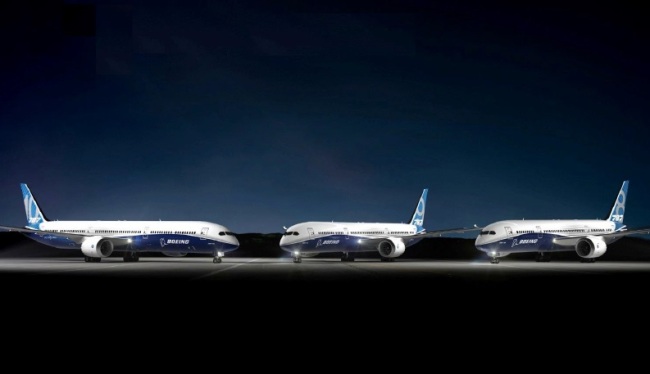[Exclusive] Samsung, Boeing in talks for future aircraft: source
By Kim Da-solPublished : March 16, 2018 - 18:34
US aircraft manufacturer Boeing has been working with South Korean tech giant Samsung Electronics to incorporate high-speed mobile technology and next-generation information systems into its latest airplane models, according to a Boeing official in Seoul on Friday.
“We are in works with Samsung and studying to use their technologies like mobile connectivity,” he told The Korea Herald.
“We are in works with Samsung and studying to use their technologies like mobile connectivity,” he told The Korea Herald.

“Korea’s global leadership in high-speed mobile technology and next-generation information systems are just a few examples of areas we continue to explore together. We continue to work closely with them to research technologies that can be introduced on our airplanes,” he said, without elaborating on details of the joint study.
Boeing has been pursuing cooperation with diverse companies to develop future aviation systems and passengers' in-flight experience.
In 2012, Boeing and Samsung signed a partnership to develop entertainment and communication technologies inside aircraft, such as by using Samsung’s electronic devices like the Galaxy Tab for displays.
It is the first time Boeing has hinted at its technical cooperation with Samsung for future aircraft.
“As airplanes become more systemic in terms of fly-by-wire, there will be a number of areas where next-generation technology can continue to play a vital role in commercial aviation, both from an operations standpoint as well as inside the cabin for passengers,” he added. Fly-by-wire refers to a semiautonomous and typically computer-regulated system for controlling the flight of an aircraft.
Samsung Electronics said it has no knowledge of such a project.
Industry watchers said that Samsung’s advanced technologies, such as wireless communications and mobile connectivity, could be crucial in developing in-flight wireless technology.
“While aircraft safety has not been tested (on the impact of mobile connectivity to the navigation system), such technologies could be extended to enhance the in-flight entertainment system and directly impact passengers’ flight experience. This is the area where Samsung can play a pivotal role,” said Yoo Chang-kyung, a professor of aerospace engineering at Inha University.
He added that Korean IT could be used to develop the next-generation fly-by-wire system, once pilotless planes become subject for commercialization.
Another industry insider echoed the view that such wireless technology could change the contents of cabin services.
“Passengers could watch visual contents in real time and credit card transactions for duty-free items could be done more conveniently,” said an engineer at a South Korean air carrier.
Meanwhile, despite the expanding low-cost carrier market and increasing popularity of single-aisle aircraft for short-distance flights, Boeing said its wide-bodied 787 models have seen growing demand.
Boeing 787 Dreamliners are designed for fuel efficiency and have low maintenance costs, using no-bleed engine architecture and raked wingtips equipped with low-noise chevrons. They can fly up to 14,140 kilometers at 25 percent fuel savings. The windows are electronically dimmable, and also 40 percent larger than those of European rival Airbus’s A350.
According to Boeing, its 787 planes are leading the market. It had received 1,319 orders from 71 customers as of last month. Deliveries will surpass 650 this month, the American aircraft maker said.
“Figures show that 787 is the ‘perfect platform’ for airlines -- especially popular in the Asia market, which is the world’s largest wide-body market. (The) 787 has the efficiency of single-aisle planes and the capacity of wide-body models,” said Darren Hulst, senior managing director of market analysis and sales support for Boeing.
According to Boeing, the Korean aviation industry has showed a gradual increase in recent years, significantly driven by the operation of LCCs.
Boeing data showed that since 2012, the portion of LCCs in the Korean market saw an annual growth rate of at least 9 percent.
Meanwhile, the global share of LCCs hit 31 percent in 2017, an increase of more than 10 percent over a decade.
By Kim Da-sol (ddd@heraldcorp.com)








![[Kim Seong-kon] Democracy and the future of South Korea](http://res.heraldm.com/phpwas/restmb_idxmake.php?idx=644&simg=/content/image/2024/04/16/20240416050802_0.jpg&u=)








![[KH Explains] Hyundai's full hybrid edge to pay off amid slow transition to pure EVs](http://res.heraldm.com/phpwas/restmb_idxmake.php?idx=652&simg=/content/image/2024/04/18/20240418050645_0.jpg&u=20240418181020)

![[Today’s K-pop] Zico drops snippet of collaboration with Jennie](http://res.heraldm.com/phpwas/restmb_idxmake.php?idx=642&simg=/content/image/2024/04/18/20240418050702_0.jpg&u=)